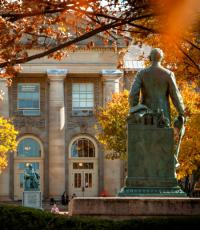This is an episode from the “What Makes Us Human?” podcast's fourth season, "What Does Water Mean for Us Humans?" from Cornell University’s College of Arts & Sciences, showcasing the newest thinking from across the disciplines about the relationship between humans and love. Featuring audio essays written and recorded by Cornell faculty, the series releases a new episode each Tuesday through the spring semester.
There are few resources, if any, more vital to life than water. The average American uses an estimated 80-100 gallons of water per day. We pass laws to protect our water sources like lakes and reservoirs, but what many people don’t know is that our access to clean water relies just as heavily on forests.
Trees serve as natural sponges, collecting and filtering rainfall and releasing it slowly into streams and rivers. They’re the most effective land cover to ensure water quality.
The rain humans rely on for agriculture and drinking is also partly thanks to trees. On average about 40% of rainfall is a result of “evapotranspiration,” which is the water that evaporates from the surface of trees and other plants and soil, plus the water a tree releases into the air. In the Amazon, as much as 70% of the rainfall comes from this process of evapotranspiration.
A healthy 100-foot-tall tree can take 11,000 gallons of water from the soil and release it into the air again, as oxygen and water vapor, in a single growing season.
This process cools the air. On an average day an individual tree can provide just as much cooling as two homes worth of air conditioning units. That is a single tree!
Right now, forests cover about a third of the earth’s surface. Amazingly, though, you don’t have to live in an area with forests to feel the moisture benefits that the forest can bring. Forests that grow along the coasts and close to oceans can draw in moist ocean air and through atmospheric circulation patterns pass that air along to continental interiors.
When we humans make the choice to cut down a forest and replace it with roads, parking lots, lawns and backyard pools, we are making a choice about more than plants and cities: we are also making a choice that affects our water supply. All of these human constructions influence how water runs off the land and how available water will be.
Our choices about trees become even more important when we consider them in the context of our changing climate, with its shifts in rainfall and other forms of precipitation. The trees we so desperately need to ensure our access to water are under attack from rising temperatures and prolonged summer droughts. Without sufficient water, trees can’t grow well; too much water deprivation, and trees begin to die.
Which raises the question: what will become of our forests and how will they function as climate change intensifies and water becomes more scarce?
Of course, plants on earth have endured plenty of droughts before. They’ve developed a whole range of physiological and anatomical adaptations to combat the stress of droughts, reduce water loss and increase their access to water sources. But this is unlikely to be enough. To ensure that the trees we need to be there for us in the decades to come, we must better understand our relationship with them and their relationship to water.
One promising avenue is to understand how trees send signals. Plants move information signals through their plant body in order to relay information such as the lack of water availability. Different tree species can have quite distinct responses to the lack of water that render sensitive species more prone to desication. Understanding this internal plant communication process could help us to decode the language of trees and help us predict future tree and forest responses to water limitation. With this knowledge we can plant our cities and manage our forests with carefully selected species that can withstand shifts in water availability and provide continued ecosystem benefits.
However we do it, one thing is clear: if we want access to clean water, we will have to recognize the role that trees play in the water cycle of the earth, and learn to value them not just for their beauty and economic value, but for their role in keeping us all alive.






